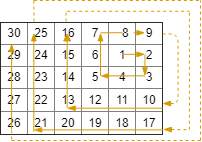- {x}
- Stone Game
- Nth Magical Number
- Profitable Schemes
- Decoded String at Index
- Boats to Save People
- Reachable Nodes In Subdivided Graph
- Projection Area of 3D Shapes
- Uncommon Words from Two Sentences
- Spiral Matrix III
- Possible Bipartition
- Super Egg Drop
- Fair Candy Swap
- Construct Binary Tree from Preorder and Postorder Traversal
- Find and Replace Pattern
- Sum of Subsequence Widths
- Surface Area of 3D Shapes
- Groups of Special-Equivalent Strings
- Read More...

Spiral Matrix III
You start at the cell (rStart, cStart) of an rows x cols grid facing east. The northwest corner is at the first row and column in the grid, and the southeast corner is at the last row and column.
You will walk in a clockwise spiral shape to visit every position in this grid. Whenever you move outside the grid's boundary, we continue our walk outside the grid (but may return to the grid boundary later.). Eventually, we reach all rows * cols spaces of the grid.
Return an array of coordinates representing the positions of the grid in the order you visited them.
Example 1:

Input: rows = 1, cols = 4, rStart = 0, cStart = 0 Output: [[0,0],[0,1],[0,2],[0,3]]
Example 2:

Input: rows = 5, cols = 6, rStart = 1, cStart = 4 Output: [[1,4],[1,5],[2,5],[2,4],[2,3],[1,3],[0,3],[0,4],[0,5],[3,5],[3,4],[3,3],[3,2],[2,2],[1,2],[0,2],[4,5],[4,4],[4,3],[4,2],[4,1],[3,1],[2,1],[1,1],[0,1],[4,0],[3,0],[2,0],[1,0],[0,0]]
Constraints:
1 <= rows, cols <= 1000 <= rStart < rows0 <= cStart < cols
Solution Explanation: Spiral Matrix III
This problem requires generating a spiral matrix traversal sequence, starting from a given point (rStart, cStart) and considering the possibility of moving outside the grid boundaries. The solution uses a simulation approach that iteratively moves in a clockwise spiral pattern.
Approach
The core idea is to simulate the spiral traversal using a loop that increases the step size (k) with each iteration. The spiral is constructed by repeatedly moving in four directions (East, South, West, North) for k steps, then increasing k by 2 to form the next layer of the spiral.
Code Explanation (Python)
The Python solution efficiently implements this approach.
class Solution:
def spiralMatrixIII(
self, rows: int, cols: int, rStart: int, cStart: int
) -> List[List[int]]:
ans = [[rStart, cStart]] # Initialize with starting point
if rows * cols == 1: # Handle trivial case of 1x1 grid
return ans
k = 1 # Initialize step size
while True: # Iterate until all cells are visited
for dr, dc, dk in [[0, 1, k], [1, 0, k], [0, -1, k + 1], [-1, 0, k + 1]]:
# Iterate through East, South, West, North directions
for _ in range(dk): # Move dk steps in current direction
rStart += dr
cStart += dc
if 0 <= rStart < rows and 0 <= cStart < cols:
# Add valid coordinates to the result
ans.append([rStart, cStart])
if len(ans) == rows * cols: # Check if all cells are visited
return ans
k += 2 # Increment step size for the next spiral layer
ans = [[rStart, cStart]]: Initializes the result list with the starting coordinates.if rows * cols == 1:: Handles the base case where the grid is 1x1.k = 1: Starts with a step size of 1.while True:: The main loop continues until all cells are visited.for dr, dc, dk in [[0, 1, k], [1, 0, k], [0, -1, k + 1], [-1, 0, k + 1]]:: This loop iterates through the four directions (East, South, West, North), wheredranddcrepresent the row and column changes, anddkis the number of steps in that direction.for _ in range(dk):: Movesdksteps in the current direction.if 0 <= rStart < rows and 0 <= cStart < cols:: Checks if the current coordinates are within the grid boundaries.ans.append([rStart, cStart]): Adds valid coordinates to the result list.if len(ans) == rows * cols:: Checks if all cells have been visited.k += 2: Increases the step size for the next spiral layer.
Time and Space Complexity
- Time Complexity: O(rows * cols), as each cell is visited exactly once.
- Space Complexity: O(rows * cols) in the worst case to store the result list. In practice, it's likely to be lower depending on the
rowsandcolsand therStart,cStartvalues.
The other code examples (Java, C++, Go, TypeScript, JavaScript) follow a similar logic, but with syntax specific to their respective languages. The core algorithmic approach remains consistent across all implementations.